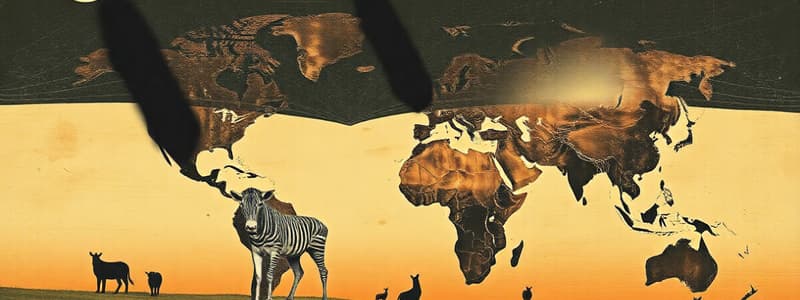Podcast
Questions and Answers
Which of the following is NOT a factor that influences population growth?
Which of the following is NOT a factor that influences population growth?
- Death rate
- Carrying capacity (correct)
- Birth rate
- Habitat destruction
What type of population distribution occurs when individuals are evenly spaced throughout an area?
What type of population distribution occurs when individuals are evenly spaced throughout an area?
- Clumped
- Exponential
- Uniform (correct)
- Random
Which of the following is an example of a density-dependent factor that can limit population growth?
Which of the following is an example of a density-dependent factor that can limit population growth?
- Earthquake
- Wildfire
- Climate change
- Disease outbreak (correct)
During exponential growth, what happens to the population size over time?
During exponential growth, what happens to the population size over time?
What is the term for the movement of individuals OUT of a population?
What is the term for the movement of individuals OUT of a population?
Which of the following is a method used to estimate population size that involves capturing, marking, and recapturing individuals?
Which of the following is a method used to estimate population size that involves capturing, marking, and recapturing individuals?
What is the maximum number of individuals that an environment can sustainably support called?
What is the maximum number of individuals that an environment can sustainably support called?
Which of the following is an example of a density-independent factor that can affect population growth?
Which of the following is an example of a density-independent factor that can affect population growth?
Flashcards
Population Size
Population Size
The total number of individuals in a specific area or group.
Population Density
Population Density
Measure of individuals per unit area.
Birth Rate
Birth Rate
Number of births per 1,000 people per year.
Death Rate
Death Rate
Signup and view all the flashcards
Carrying Capacity
Carrying Capacity
Signup and view all the flashcards
Exponential Growth
Exponential Growth
Signup and view all the flashcards
Density-Dependent Factors
Density-Dependent Factors
Signup and view all the flashcards
Sampling Techniques
Sampling Techniques
Signup and view all the flashcards
Study Notes
Population Dynamics
- Population size refers to the total number of individuals in a specific area or group.
- Population density is a measure of the number of individuals per unit area.
- Population growth is the change in the size of a population over a period of time.
- Factors influencing population growth include birth rate, death rate, immigration, and emigration.
- Birth rate is the number of births per 1,000 people per year.
- Death rate is the number of deaths per 1,000 people per year.
- Immigration is the movement of individuals into a population.
- Emigration is the movement of individuals out of a population.
Population Distribution
- Population distribution refers to the spatial arrangement of individuals within a given area.
- Patterns of distribution can be random, uniform, or clumped.
- Random distribution occurs when individuals are spaced out in an unpredictable pattern.
- Uniform distribution occurs when individuals are spaced evenly throughout the area.
- Clumped distribution occurs when individuals cluster together in specific areas.
- Factors influencing population distribution include resources, biotic interactions, and environmental conditions.
Population Growth Models
- Exponential growth occurs when a population increases at a constant rate.
- Logistic growth occurs when a population's growth rate slows as it approaches its carrying capacity.
- Carrying capacity is the maximum number of individuals that an environment can sustainably support.
- The carrying capacity of an environment is influenced by factors such as the availability of resources, predation, and disease.
- Factors limiting population growth are classified as either density-dependent or density-independent.
- Density-dependent factors affect population size in relation to population density.
- Examples include competition for resources, predation, and disease.
- Density-independent factors affect population size regardless of population density.
- Examples include natural disasters, climate change, and habitat destruction.
Population Measurement
- Various methods are used to estimate and monitor population size, including direct counts, sampling techniques, mark-recapture methods, and remote sensing.
- Direct counts are used when the population is relatively small and accessible.
- Sampling techniques are used when the population is large or difficult to access.
- Mark-recapture methods involve marking individuals, releasing them, and then recapturing them to estimate population size.
- Remote sensing techniques, like aerial photography or satellite imagery, can be used to monitor large populations in vast areas.
Human Population
- Human population growth has been significant and rapid throughout history.
- Factors contributing to the increase in human population include improved sanitation, healthcare, and agriculture.
- Concerns exist regarding the environmental impact of the rapidly increasing human population, such as resource depletion and pollution.
- Understanding human population dynamics is important to effectively manage resources and the environment.
Studying That Suits You
Use AI to generate personalized quizzes and flashcards to suit your learning preferences.




